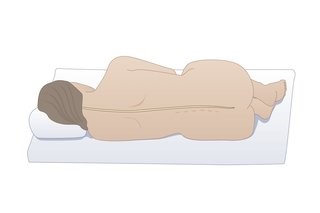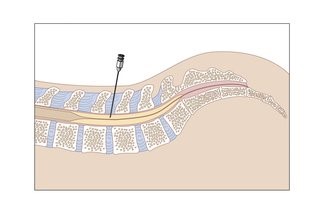Home » Services » Interventional procedures » Spinal Cord Biopsy – Lumbar puncture
Spinal cord biopsy - Lumbar puncture
A lumbar puncture (spinal tap) is performed in your lower back, in the lumbar region. During a lumbar puncture, a needle is inserted between two lumbar bones (vertebrae) to remove a sample of cerebrospinal fluid. This is the fluid that surrounds your brain and spinal cord to protect them from injury. It should not be painful, but you may have a headache and some back pain for a few days.
It’s carried out in hospital by a doctor or specialist nurse.
Why might I need a lumbar puncture?
A lumbar puncture may be done for various reasons.
The most common reason is to remove a small amount of CSF for testing. This can help in the diagnosis of various disorders. The fluid is tested for red and white blood cells, protein, and glucose (sugar). The clarity and color of the fluid are also checked and it is tested to see whether bacteria, viruses, or abnormal cells are present.
Excess CSF may also be removed in people who have an overproduction or decreased absorption of the fluid.
A lumbar puncture procedure may be helpful in diagnosing many diseases and disorders, including:
- An inflammation of the membrane covering the brain and spinal cord. The inflammation is usually the result of a viral, bacterial, or fungal infection.
- An inflammation of the brain that is usually caused by a virus.
- Certain cancers involving the brain and spinal cord
- Bleeding in the area between the brain and the tissues that cover it (subarachnoid space)
- Reye syndrome. A sometimes fatal disease that causes severe problems with the brain and other organs. Although the exact cause of the disease is not known, it has been linked to giving some medications to children. It is now advised not to give drugs to children during illnesses, unless prescribed by your child’s healthcare provider.
- An inflammation of the spinal cord or bone marrow.
- A stage of syphilis during which the bacteria invades the central nervous system.
- Guillain-Barré syndrome. A disorder in which the body’s immune system attacks part of the nervous system.
- Demyelinating diseases. Diseases that attack the protective coating that surrounds certain nerve fibers – for example, multiple sclerosis or acute demyelination polyneuropathy.
- Headaches of unknown cause. After evaluation and head imaging if necessary, a lumbar puncture may be done to diagnose certain inflammatory conditions that can result in a headache.
- Pseudotumor cerebri (also called idiopathic intracranial hypertension, or IIH). In this condition,pressure within the subarachnoid space is elevated for reasons that are not clear. A lumbar puncture is only done in this condition after evaluation and head imaging.
- Normal pressure hydrocephalus. A rare condition affecting mainly older people in which there is a triad of loss of urinary control, memory problems, and an unsteady gait. A lumbar puncture is done to see if the pressure of the CSF is elevated or not.
In addition, a lumbar puncture may be used to measure the pressure of the CSF. The healthcare provider uses a special tube (called a manometer) to measures the pressure during a lumbar puncture.
Finally, a lumbar puncture may be done to inject medicine directly into the spinal cord. These include:
- Spinal anesthetics before a surgical procedure
- Contrast dye for X-ray studies – for example, myelography
- Chemotherapy drugs used to treat cancer
Before having a lumbar puncture
Your doctor or nurse should explain what’s going to happen and why you need a lumbar puncture.
A few days or weeks before the test:
- you may have a CT scan or MRI scan – to make sure you need the lumbar puncture and it’s safe to have one
- let the hospital know if you’re taking blood-thinning medicine (anticoagulants) – such as warfarin
On the day:
- you can eat, drink and take medicine as normal
- you’ll be asked to sign a consent form
- you’ll usually need to undress and change into a hospital gown before the procedure
- you might also want to use the toilet
What happens during a lumbar puncture
The doctor or nurse will:
- Clean your skin and numb the area with local anaesthetic (you’ll be awake during the procedure). Children may also be given medicine to help them relax and keep still.
- Insert a thin needle through the skin, between 2 bones in the lower part of your spine. This should not be painful, but you may feel some pressure.
- Remove the needle once the procedure is finished and apply a small plaster or dressing.

You normally lie on your side, with your legs pulled up and your chin tucked in

This allows the needle to be inserted between the bones more easily
How long does a lumbar puncture take?
A lumbar puncture takes around 30 to 45 minutes, but you’ll need to stay lying down at the hospital for at least another hour while the nurses monitor you.
You’ll be able to go home the same day if you feel well enough, but you would not be able to drive yourself home.
Results of the lumbar puncture
The spinal fluid samples are sent to a laboratory for analysis. The doctor or nurse who performs the lumbar puncture can often tell you some of the results straight away and explain what they mean.
You may need to wait for at least 48 hours for the full results. Some laboratory test results are available within a couple of hours in an emergency. Lab technicians check for a number of things when examining spinal fluid, including:
- General appearance.Spinal fluid is normally clear and colorless. If it’s cloudy, yellow or pink in color, it might indicate abnormal bleeding. Spinal fluid that is green might indicate an infection or the presence of bilirubin.
- Protein (total protein and the presence of certain proteins).Elevated levels of total protein — greater than 45 milligrams per deciliter (mg/dL) — may indicate an infection or another inflammatory condition. Specific lab values may vary from medical facility to medical facility.
- White blood cells.Spinal fluid normally contains up to 5 white blood cells (mononuclear leukocytes) per microliter. Increased numbers may indicate an infection. Specific lab values may vary from medical facility to medical facility.
- Sugar (glucose).A low glucose level in spinal fluid may indicate infection or another condition.
- The presence of bacteria, viruses, fungi or other microorganisms can indicate an infection.
- Cancer cells.The presence of abnormal cells in spinal fluid — such as tumor or immature blood cells — can indicate certain types of cancer.
Lab results are combined with information obtained during the test, such as spinal fluid pressure, to help establish a possible diagnosis.
Your health care professional generally gives you the results within a few days, but it could take longer. Ask when you can expect to receive the results of your test.
Side effects of a lumbar puncture
A lumbar puncture is generally a safe procedure and serious side effects are uncommon.
The most common side effects are:
- headaches, which can last for up to a week – you’ll be given painkillers at the hospital if you need them
- swelling and lower back pain where the needle was inserted – this should get better on its own after a few days and is normally nothing to worry about
Recovering from a lumbar puncture
While you’re recovering from a lumbar puncture:
Do
- drink plenty of fluids
- take painkillers, such as paracetamol
- lie down instead of sitting upright
- try drinks containing caffeine, such as coffee, tea or cola – some people find this helps to relieve the headaches
- remove the dressing or plaster yourself the next day
Don’t
- do not drive or operate machinery for at least 24 hours
- do not play sport or do any strenuous activities for at least a week
Contact the hospital team or a GP if:
- your headaches are severe or do not go away
- you’re feeling or being sick
- you have a very high temperature or feel hot and shivery
- it’s painful to look at bright lights
- the swelling in your back lasts for more than a few days or keeps getting worse
- you see blood or clear fluid leaking from your back
Our doctors and medical staff are higly trained professionals and Puls Cardiology Center is fully equiped to performe lumbar puncture and biopsy. If you have any aditional questions or you want to make an apointment please reach us by phone 0117555000 or email: info@pulskardioloskicentar.rs
